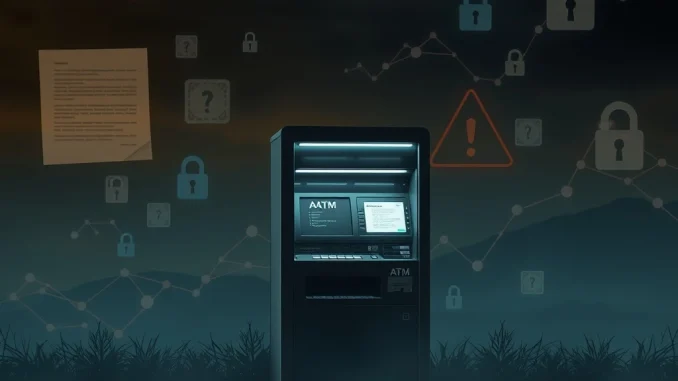
The **crypto ATM industry**, once hailed as a gateway to decentralized finance, is now navigating a complex and often perilous landscape. What began as a symbol of accessible crypto for the masses has evolved into a sector grappling with intense regulatory scrutiny, escalating security risks, and fierce market competition. For investors and operators alike, understanding these shifting tides is paramount. If you’re considering a venture into this space, prepare for a journey where vigilance is key.
The Crypto ATM Industry’s Evolving Landscape
From 2023 to 2025, the **crypto ATM industry** has witnessed a seismic shift. Policymakers are prioritizing consumer protection, anti-money laundering (AML) enforcement, and market stability more than ever before. This pivot from a ‘Wild West’ approach to a more structured environment presents significant questions for new entrants: Can startups truly afford the burgeoning compliance costs? Will the persistent threat of security risks erode their profitability? And how will evolving legislation fundamentally shape the industry’s future?
Unpacking Regulatory Scrutiny: A New Era of Compliance
Both the U.S. and the EU have transitioned from a ‘regulate by enforcement’ model to more structured, collaborative approaches. President Trump’s 2025 executive order, establishing the President’s Working Group on Digital Asset Markets, signaled a clear move towards regulatory clarity. Similarly, the EU’s Markets in Crypto-Assets (MiCA) regulation, fully implemented in late 2024, created a unified framework for stablecoins and crypto service providers. While these shifts promise long-term institutional adoption, they significantly raise the bar for **crypto compliance**.
For crypto ATM operators, the stakes are high. Under FinCEN’s 2019 guidance, operators are classified as money transmitters, necessitating registration under the Bank Secrecy Act. This mandates costly Know-Your-Customer (KYC) protocols, such as biometric verification or app-based identity checks. State-level legislation further compounds these costs. For example:
- California and Maryland now impose daily transaction caps of $1,000–$2,000.
- Fee limits of 3–15% directly reduce revenue per machine in various jurisdictions.
This heightened **regulatory scrutiny** demands robust operational frameworks and significant upfront investment.
Confronting Security Risks and Pervasive Fraud
Beyond regulatory hurdles, mounting **security risks** have become a critical barrier. The FBI reported a tenfold increase in crypto ATM fraud complaints between 2020 and 2023, with seniors disproportionately targeted. The high markup on exchange rates—often 5–23%—creates strong incentives for fraudsters to exploit price discrepancies. For instance, a scammer might withdraw Bitcoin at a crypto ATM with a 20% markup and immediately sell it on an online exchange for a 15% profit, pocketing the difference.
Physical security is another pressing concern. With nearly 38,000 crypto ATMs globally by early 2025, operators face constant threats of theft, vandalism, and even machine tampering. The increasing sophistication of blockchain analytics tools, designed to detect fraudulent activity, adds layers of complexity, requiring operators to invest in real-time monitoring capabilities to mitigate these persistent **security risks**.
Is the Crypto ATM Market Saturated?
The rapid proliferation of crypto ATMs has led to a saturated market, consequently driving down average revenue per machine. Operators like Ryan Rudden of Hodl Bitcoin ATMs note that smaller players struggle to differentiate themselves beyond basic compliance offerings. Furthermore, state-level bans or severe restrictions—such as New Jersey’s proposed outright kiosk bans—threaten profitability for many. Meanwhile, consumers increasingly favor online exchanges, which typically offer lower fees and fewer KYC hurdles, forcing the **crypto ATM industry** to justify its unique value proposition in an increasingly competitive environment.
Strategic Crypto ATM Investment: Navigating the Hurdles
For investors, the **crypto ATM investment** sector now demands a highly nuanced approach. While the long-term prospect of regulatory clarity could eventually spur institutional adoption, the near-term risks are acute. Startups lacking deep pockets may falter under the weight of compliance costs, while those unable to secure strategic partnerships with leading blockchain analytics firms (e.g., Chainalysis) will struggle to meet stringent AML requirements. Key investment considerations include:
- Compliance as a Competitive Edge: Firms that seamlessly integrate advanced AML tools and user-friendly KYC workflows, such as biometric verification, are likely to outperform their peers.
- Geographic Diversification: Operators with a strategic presence in states with favorable legislation (e.g., Texas, Nevada) may effectively mitigate risks posed by more restrictive states.
- Partnerships Over Solo Operations: Collaborations with established banks or fintech companies can significantly reduce compliance burdens and enhance overall credibility.
- Security Innovation: Investments in cutting-edge hardware-based fraud detection or AI-driven transaction monitoring systems could provide crucial differentiation in a crowded market.
Conclusion: Navigating the New Normal
The **crypto ATM industry** stands at a critical crossroads. While the emergence of regulatory frameworks like MiCA and the efforts of the U.S. Working Group provide long-term optimism, the immediate hurdles are formidable. For new entrants, the path to profitability hinges on a delicate balance between rigorous compliance and continuous innovation. Investors must carefully weigh these immediate challenges against the sector’s long-term potential, favoring companies that prioritize robust security measures, adaptability to evolving regulations, and keen regulatory foresight. In an era of heightened scrutiny, the survivors will be those who view **crypto compliance** not as a burden, but as the foundational pillar for trust and sustainable growth.
Frequently Asked Questions (FAQs)
Q1: What are the main regulatory challenges facing crypto ATMs?
The primary regulatory challenges include classification as money transmitters under FinCEN guidance, requiring costly AML and KYC protocols, and navigating diverse state-level legislations that impose transaction caps and fee limits. International frameworks like MiCA also add layers of compliance complexity.
Q2: How do security risks impact the crypto ATM industry?
Security risks manifest as increased fraud complaints (especially targeting vulnerable populations), exploitation of high transaction markups by fraudsters, and physical security concerns like theft, vandalism, and machine tampering. Operators must invest in advanced blockchain analytics and real-time monitoring to mitigate these threats.
Q3: Why are compliance costs a significant barrier to entry for new crypto ATM operators?
Compliance costs are substantial due to the necessity of implementing robust KYC procedures (e.g., biometric verification), registering under the Bank Secrecy Act, and adhering to various state-specific regulations. These costs can be prohibitive for startups lacking significant capital, making it difficult to compete with established players.
Q4: What should investors consider before investing in the crypto ATM sector?
Investors should prioritize companies that demonstrate strong compliance frameworks, including partnerships with blockchain analytics firms. Geographic diversification to states with favorable regulations, strategic collaborations with financial institutions, and investment in innovative security technologies are also key considerations to mitigate risks and identify potential for growth.
Q5: How does the crypto ATM industry compare to online crypto exchanges?
Crypto ATMs offer immediate cash-to-crypto conversion and physical access, which can be convenient for some users. However, they typically have higher fees and more stringent KYC requirements compared to online exchanges. Online exchanges often provide lower fees, a wider range of assets, and greater liquidity, which can make them more appealing to tech-savvy users.



